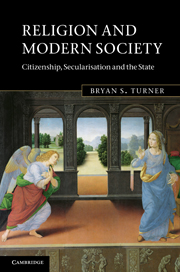Book contents
- Frontmatter
- Contents
- Acknowledgements
- Introduction: the state of the sociology of religion
- Part I Theoretical frameworks: the problem of religion in sociology
- 1 Religion, religions and the body
- 2 Émile Durkheim and the classification of religion
- 3 Max Weber and comparative religion
- 4 Talcott Parsons and the expressive revolution
- 5 Mary Douglas and Modern Primitives
- 6 Pierre Bourdieu and religious practice
- Part II Religion, state and post-secularity
- References
- Index
2 - Émile Durkheim and the classification of religion
Published online by Cambridge University Press: 05 June 2012
- Frontmatter
- Contents
- Acknowledgements
- Introduction: the state of the sociology of religion
- Part I Theoretical frameworks: the problem of religion in sociology
- 1 Religion, religions and the body
- 2 Émile Durkheim and the classification of religion
- 3 Max Weber and comparative religion
- 4 Talcott Parsons and the expressive revolution
- 5 Mary Douglas and Modern Primitives
- 6 Pierre Bourdieu and religious practice
- Part II Religion, state and post-secularity
- References
- Index
Summary
Introduction: the social and the sacred
Why read Émile Durkheim, and in particular why immerse ourselves in a study ostensibly about Australian Aboriginals from material that had been gathered at the end of the nineteenth century by British colonial administrators? Although Aboriginal religious practices may appear to have only curiosity value, a century later interest in Durkheim's sociology of religion appears to be growing. While the secularisation paradigm was dominant in sociological theory in the 1960s, Durkheim's fortunes in professional sociology were relatively low. The contemporary revival of the sociology of religion and the apparent influence of religion globally, especially in the political sphere, has restored the idea that religion is somehow critical to the actual constitution of the social world. The current political crises around the state and religion have made Durkheim's Elementary Forms ([1912] 2001) once more a salient topic of social and political theory. As a result, contemporary philosophers such as Charles Taylor, when seeking to analyse contemporary societies in his Varieties of Religion Today (2002), constantly invoke Durkheim as a source of inspiration and as a paradigm for understanding the public role of religion. There has also been a return to the question of the sacred in modernity in Massimo Rosati's Ritual and the Sacred (2009), and a special issue of the Scandinavian journal Distinktion on the sacred has been recently published (Arppe and Borch, 2009).
- Type
- Chapter
- Information
- Religion and Modern SocietyCitizenship, Secularisation and the State, pp. 30 - 52Publisher: Cambridge University PressPrint publication year: 2011



